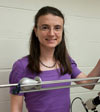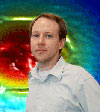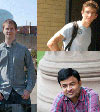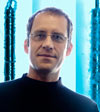NSE Spotlight Archives :: 2010

|
Spotlight on NSE Alumni | Dr. Andrew Cook: The Engineer as ExecutiveSuccessful technology-driven companies build an ongoing connection between their product development efforts, and the problems, needs and goals of their customers. This process requires technically skilled people who can also manage teams, build relationships, and adapt to changing conditions. One example: Andrew Cook (NUE '76, SM '76, PhD '78), who serves as Senior VP of Customer Relations and Marketing for AREVA, a global developer of nuclear and renewable energy. more |

|
Spotlight on NSE Research | Silicon Carbide Cladding Proves its MettleInnovation is powerful, but in a field like nuclear engineering, new materials, designs and processes must prove their merit under all foreseeable conditions before moving into everyday use. An NSE team is using specialized facilities of the MIT Nuclear Reactor Laboratory to evaluate a new approach to protecting reactor fuel rods, with the prospect of enabling better reactor performance and safety, while also reducing waste production. more |

|
Spotlight on NSE Research | Better Fuel Cells and Reactors, Built From the Atomic LevelMaterials are one of the key enablers in any engineering project. Bridge builders, who once worked in stone, and then in steel, can now draw on carbon fiber, polymers, and composites with outstanding strength, weight and other characteristics that extend the engineer's capabilities. Engineers developing advanced energy technologies like fuel cells and new-generation reactors will benefit from novel materials knowledge being developed at NSE's Laboratory for Electrochemical Interfaces, headed by Assistant Professor Bilge Yildiz. Researchers there are working towards better understanding of the interfacial properties of oxides and learning to tailor their levels of ion transport, which could help create components with increased resistance to corrosion and other specialized properties. more |

|
Spotlight on NSE Research | Better Models for Better ReactorsWhen engineers develop a complex new system, they typically compensate for a lack of field experience by overbuilding - extra material and heavy construction help create margin for error. This trend is seen in everyday life with airplanes, cars, and motorboats for example; over time, with more data and better computer-aided simulation and design, all have become lighter and more efficient, with better performance and improved safety. more |

|
Spotlight on Bishop Fellows | Strategies for safe, economically competitive nuclear powerOver the next few decades, the United States and the world will confront two monumental challenges: increasing pressure on oil and gas supplies, and climate change. Our effectiveness at addressing these interconnected problems will have a major impact on the global economy, and on the quality of life for future generations. NSE faculty and students are working on both strategic and operational aspects of these challenges, looking at broad energy-related strategies while also pursuing practical ways of enhancing the economic and safety performance of nuclear energy technologies. Since 2006 this work has received support from John M. Bishop, a Canadian engineer and environmentalist with a desire to help develop new means of providing for future energy needs. more |

|
Spotlight on NSE Research | The Power of NanofluidsCooling processes are central to nuclear power generation, which is widely seen as an important factor in the global reduction of carbon emissions over coming decades. Most reactors today use plain water as a stand-by cooling agent for cases of core overheating, but research led by Buongiorno, the Carl R. Soderberg Professor of Power Engineering, has demonstrated that the addition of nanoparticles to the cooling water provides up to a 100 percent increase in the amount of heat that can be quickly removed from the core. The particles are tiny bits of material such as alumina and diamond, just a few hundred molecules across; researchers are exploring their use in a wide range of materials applications. more |

|
Spotlight on NSE Young FacultyThe faculty of the Department of Nuclear Science and Engineering includes six outstanding young educators and researchers, four of whom only recently joined the Department. The exciting research of these young faculty members is helping the Department achieve its goal of building an exceptionally strong community of researchers in nuclear and radiation science and technology centering on the Department and reaching across MIT. more |
